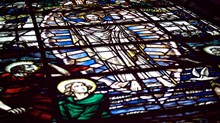
As the feast of Easter developed in Christian tradition, so did the festival's preparatory period, known as Lent. This involved fasting and later abstinence from certain foods, including eggs. The festal letter of Athanasius in 330 shows that the early church was practising a 40-day fast prior to Easter (also indicated in Canon V of the first Nicene Council). The fifth-century church historian Socrates Scholasticus noted, "Some abstain from eggs …" Canon LVI of the Council in Trullo, 692, enjoined such abstinence: "It seems good therefore that the whole Church of God which is in all the world should follow one rule and keep the fast perfectly, and as they abstain from everything which is killed, so also should they from eggs and cheese, which are the fruit and produce of those animals from which we abstain."
By the time of the medieval theologian Thomas Aquinas (c. 1225-74), eggs, milk, and meat were all forbidden during Lent: "Eggs and milk foods are forbidden to those who fast, for as much as they originate from animals that provide us with flesh … Again the Lenten fast is the most solemn of all, both because it is kept in imitation of Christ, and because it disposes us to celebrate devoutly the mysteries of our redemption. For this reason the eating of flesh meat is forbidden in every fast, while the Lenten fast lays a general prohibition even on eggs and milk foods."
In pre-refrigeration days, it would be difficult to preserve milk and meat products until Easter, but the same was not true of eggs. Eggs, which unlike other foods do not perish quickly, were therefore a natural way to break the fast on Easter Sunday. Presenting gifts of eggs at Easter has a long and culturally diverse lineage. Practicality was one factor: Given that hens would be laying eggs throughout Lent, a surplus would exist by Easter, probably at lower prices. (Notably, the Jewish Passover Seder meal includes a hard-boiled egg symbolising the sacrifice at, and subsequently the destruction of, the Jerusalem temple. Whether this had any influence on the development of Easter eggs in their initial form cannot be determined.)
Dyeing and Resurrection
The coloring of eggs is associated with various legends. An ancient story recounts Mary Magdalene being summoned by Emperor Tiberius and stating that Christ had been resurrected. The skeptical Caesar pointed to an egg and exclaimed, "Christ has not risen, no more than that egg is red"—after which the egg in question miraculously turned blood-red. One Eastern Orthodox myth presents either Mary Magdalene or Mary, the mother of Jesus, placing a basket of eggs under the cross. The blood of Christ fell on the eggs, turning them red. According to another tale, Simon of Cyrene was an egg merchant who had to leave his basket of eggs to help Jesus carry the cross. When he returned, he found that his eggs had changed color!
These tales have traditionally been taken as the basis for dyeing eggs (sometimes blessed at Orthodox masses). Venetia Newall observes, "Throughout Europe one finds that, while all the colors of the rainbow appear, red is by far the most usual for egg dyeing, especially in countries of the Orthodox faith. 'Oh, when will Easter come,' runs a Macedonian children's rhyme, 'bringing with her red eggs?'"
Of course, painting or dyeing eggs is a practice found in many cultures at different times, and there are indications of such practices in the British Isles during the Middle Ages. In 1290, the English King Edward I obtained eggs that were "boiled and stained, or covered with leaf gold, and afterwards distributed to the royal household at Easter" (William Hone, The Every-Day Book) (quot (quoted in William Hone, William, The Every-Day Book [London: Hunt & Clark, 1826], p. 429). An egg in a silver case was sent from the Vatican to King Henry VIII. The most famous modern counterpart of this is the renowned Fabergé egg, first made in 1885 for Tsar Alexander III as an Easter present to his wife, Tsaritsa Maria. People were coloring eggs by one method or another in various parts of Britain, especially northern England, in the 18th century; they called the eggs "Pace-eggs," from the Greek word paschal. Chocolate Easter eggs emerged in the 19th century and became mass-produced and generally popular by the following century.
Children eagerly anticipate Easter because of the joy that Easter eggs bring. But the joy associated with Easter traditions is dependent upon the celebration of Christ's triumph over death, and the popular anticipation associated with eggs on Easter Sunday must always be surpassed by the greater anticipation that the day celebrates—the assured hope of Christ's return and the general resurrection to come.
Anthony McRoy is a Fellow of the British Society for Middle East Studies and lecturer in Islamic studies at Wales Evangelical School of Theology, U.K.
For further reading:
Newall, Venetia, An Egg at Easter: A Folklore Study (London: Routledge & Kegan Paul, 1971)
Hone, William, The Every-Day Book (London: Hunt & Clark, 1826)
Hutton, Ronald, The Stations of the Sun: A History of the Ritual Year in Britain (Oxford: Oxford University Press, 1996)
Copyright © 2010 by the author or Christianity Today/Christian History & Biography magazine.
Click here for reprint information on Christian History & Biography.

Support Our Work
Subscribe to CT for less than $4.25/month




























